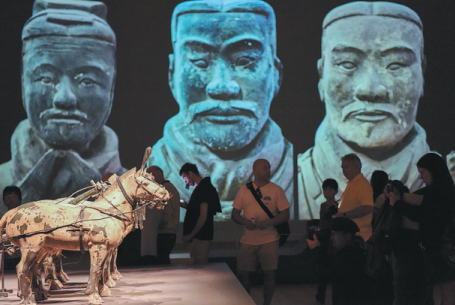Cultural relics on display in 2019

BEIJING-Numerous Chinese cultural and art treasures have been put on show in many parts of the world over this past year, with sculptures, calligraphy, ceramics and imperial belongings showcasing the charms of Chinese civilization on the global stage and facilitating cultural exchanges.
Last December, New Zealand's national museum in Wellington launched a four-month exhibition, Terracotta Warriors: Guardians of Immortality, about the Terracotta Army, an imperial icon of Chinese art and civilization. On the opening day, local residents lined up to see a selection of the life-size clay models of soldiers, horses and chariots that were meant to guard the tomb of Emperor Qinshihuang around 2,000 years ago.
More than 160 ancient antique pieces made of gold, jade and bronze were also displayed, providing visitors with a glimpse of the long-standing charms of Chinese civilization.
The exhibition represents a "once in a lifetime" experience, says curator Rebecca Rice.
She says that people can appreciate the individuality of each terracotta warrior and the incredible creativity needed to build the army.
At the opening ceremony, New Zealand's Tourism Minister Kelvin Davis says the exhibition "will encourage more New Zealanders to continue their journey to engage with and understand China, one of our most important partners".
Treasures showing the lives of emperors and empresses from the Qing Dynasty (1644-1911) also went on display in museums in Washington DC and Moscow in the first half of this year, with over 100 exhibits being put on display, including imperial portraits, narrative paintings, furnishings, jewelry and costumes from the Palace Museum in Beijing.
Elena Gagarina, general director of the Moscow Kremlin Museums, says the exhibition Treasures from the Palace Museum: The Flourishing of China in the 18th Century in Moscow was a success.
Russian visitors appreciated the range of exhibits, she adds.
Museums have also explored new techniques to add more fun to the visitor experience.
On Jan 30, ahead of Spring Festival, a Chinese cultural exhibition kicked off at the Guimet National Museum of Asian Arts in Paris, offering people an interactive and immersive experience with Chinese New Year customs and rituals.
Using the WeChat app on their smartphones, visitors can design scarves using the exquisite patterns found in the ancient paintings at the Mogao Grottoes, a UNESCO World Heritage Site in Northwest China's Gansu province, and wear their self-designed scarves to celebrate the traditional Chinese festival.
Receiving red packets of "lucky money" from senior members of a family, a Spring Festival tradition, was presented in a digitized form at the exhibition through mobile payment technology.
Digital technology has created new ways to exhibit cultural relics from China. Earlier this year, Chinese tech giant Tencent and France's union of national museums signed a memorandum to enhance cultural exchanges, inheritance and innovation. Under this framework, the two sides unveiled a number of exhibitions to present the Chinese treasures collected by French museums in a digital format.
Patrick Dambron, chairman of the France-China Art and Culture Academy, says technology has enabled cultural heritage to regain its vitality, and is encouraging the younger generation to inject vigor into modern and traditional arts and culture.
Chinese and foreign museums have been forging exchanges to facilitate a dialogue between civilizations and foster people's understanding of and engagement with cultures that interest them. The British Museum opened a souvenir store on the Chinese online shopping platform Tmall in July 2018. The shop has accumulated more than 1 million followers.
Everyday items that online buyers snap up feature elements from the artifacts, such as mugs in the shape of the Gayer-Anderson Cat, one of the most loved items in the museum's collection, and silk scarves with patterns from Italian majolica plates. The British Museum inked a deal last December with Tmall to expand their partnership beyond sales to include marketing, localized content and product-licensing for three years.
An important mission of the museum is to share the exhibits with the rest of the world, says British Museum Chairman Richard Lambert, adding that the project brings them closer to Chinese people.
Chinese museums have inked deals with their counterparts in Australia, Russia and Greece to enhance cooperation in exhibitions and the protection of cultural relics. The Acropolis Museum in Athens, for instance, has established partnerships with the Shanghai Museum and the Palace Museum to stage exhibitions and hold art workshops.
Dimitrios Pandermalis, president of the Acropolis Museum, says the collaboration between his museum and the Palace Museum has been fruitful, adding that such synergies bring the two cultures closer together and broaden Sino-Greek ties.
Dialogue between the two cultures are set to continue, says Pandermalis, adding that both sides can share their knowledge in many more fields of expertise.
One field where the two sides can exchange experience is conservation, he adds.

Today's Top News
- Another sign of Japan's right-wingers' dangerous ambition to break free of all postwar constraints
- Hainan's special customs operations start strong
- Macao SAR holds flag-raising, reception to mark 26th anniversary of return to motherland
- China issues rules to regulate pricing practices of internet platforms
- US hits over 70 IS-linked targets in Syria in massive retaliatory strikes
- Coffee needs cooperation, not confrontation






























